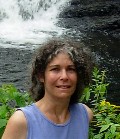Reading Our Region
Essays from a Regional Writer
 Susan Charkes enjoys hearing and telling stories, especially those involving the environment, farming, and sustainability in our region. Discover her poetic view of the outdoors and be inspired to visit the places she describes. Learn more about Susan, her writing, and even hear her podcasts at www.susancharkes.com.
Susan Charkes enjoys hearing and telling stories, especially those involving the environment, farming, and sustainability in our region. Discover her poetic view of the outdoors and be inspired to visit the places she describes. Learn more about Susan, her writing, and even hear her podcasts at www.susancharkes.com.
Sample these selected writings:
| Featured Items: |
Who Would Have Thought?
by Susan Charkes
Nature, doing just as we expect, comforts us with a sense of the fundamental order of things: the cycle of seasons, the beauty of a familiar place.
Butterflies float through meadows of summer wildflowers, pausing here and there to sip nectar from the blossoms. Tree leaves turn orange in autumn and fall to the ground, where they dry, fade to brown and become new soil.
 Nature, confounding our expectations, surprises us into delight born of insight into the possibilities of the unthought-of.
Nature, confounding our expectations, surprises us into delight born of insight into the possibilities of the unthought-of.
In the woods, one warm sunny day in late winter or early spring, a dead brown leaf detaches itself from a log, stretches, and floats up to a tree branch, whereupon it turns brilliant orange splattered with black.
The Question Mark butterfly is so called because of the silvery squiggle that adorns the underside of its gaily patterned orange and black wings. But this butterfly is aptly named for another reason: it makes us question our assumptions.
Almost all butterflies in our region pass the winter in an immature form -- an egg, a caterpillar or a pupa -- waiting for a spring metamorphosis. The Question Mark is one of the very few (the Mourning Cloak and Eastern Comma are others) that overwinters as an adult. It hibernates, hidden behind a loose shred of bark or tucked inside a hollow log, its wings folded. In contrast to the brightly colored topside, the underside of the Question Mark’s wings are dull brown with vein-like lines, and the edges are deeply hooked and lobed: camouflage that enables it to hide in plain sight, like a dead leaf in the detritus of the forest floor.
With the arrival of warmer weather the drowsing Question Mark awakens and emerges from hiding to find a mate. It is one of the earliest, and most brightly colored, harbingers of spring in the woods, still bare of green leaves. The males perch on branches, wings spread in the bright light, while females roam the forest apprising each potential suitor.
Like the wood thrush, or the millipede, the Question Mark is a creature of woodlands, adapted to thrive in the complex web of relationships that comprise the forest. Instead of feeding on nectar from flowers, as do many other butterflies, it seeks out sap from maple, beech or birch trees. Sap flows freely on warm days that follow cold nights; the butterfly takes advantage of the feeding holes tapped by other insects or by the yellow-bellied sapsucker, alighting on tree trunks and folding its wings to pretend to be a leaf as it drinks, hidden from predators.
Or it forages for nutrients from the leavings of other woodland residents: scat, carrion, rotting fruit. The gentle flutter of orange as the butterfly slowly moves its wings, savoring its meal of warm dung freshly laid on the forest floor, beckons us to bend and admire it as we walk through an early spring woods. Can we help but recoil as we approach? Do we not wish instead to find this fragile beauty on a lovely blossom?
If nature were only what we wished for, would we love it so?
Learn more at http://www.butterfliesandmoths.org/species/Polygonia-interrogationis.
© Susan Charkes 2011

